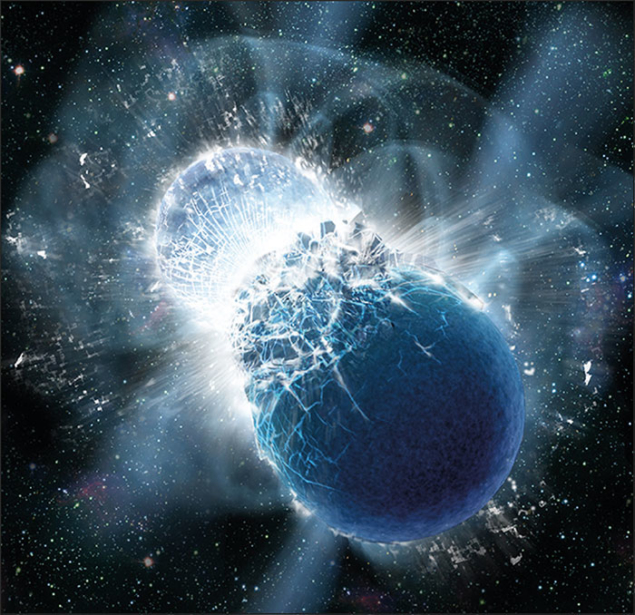
Image credit: Dana Berry/Skyworks Digital, Inc./The Kavli Foundation.
The origin of some of the heaviest chemical elements is due to rapid neutron capture, but the precise location where this cosmic alchemy takes place has been under debate for several decades. While core-collapse supernovae were thought to be the prime production site, a new study suggests that elements heavier than zinc originate from the merger of two neutron stars. Such a dramatic event would have been responsible for the extreme heavy-element enrichment observed in several stars of an ancient dwarf galaxy called Reticulum II.
Nuclear fusion in the core of massive stars produces elements up to and including iron, which is a stable nucleus with the highest binding energy per nucleon. Building heavier nuclei requires energy to compensate for the loss of nuclear binding and is therefore almost impossible to achieve experimentally. But under certain conditions, stars can produce heavier elements by allowing them to capture protons or neutrons.
The relative abundance of certain elements therefore tells researchers whether nucleosynthesis followed an s- or an r-process.
Neutron capture, which is unaffected by Coulomb repulsion, occurs either slowly (s) or rapidly (r). Slow neutron captures occur at a pace that allows the nucleus to undergo beta decay prior to a new capture, and therefore to grow following the line of nuclear stability. The r-process, on the other hand, causes a nucleus to accumulate many additional neutrons prior to radioactive decay. The relative abundance of certain elements therefore tells researchers whether nucleosynthesis followed an s- or an r-process. The rare-earth element europium is a typical r-process element, as are gold, lead and uranium.
For the r-process to work, nuclei need to be under heavy neutron bombardment in conditions that are only found in dramatic events such as a core-collapse supernova or in mergers of two neutron stars. The supernova hypothesis has long been the most probable candidate for the r-process, whereas other scenarios involving rarer events, such as encounters between a neutron star and a black hole, have only been considered since the 1970s. One way to distinguish between the two hypotheses is to study low-metallicity galaxies in which the enrichment of heavy elements is low. This enables astrophysicists to determine if the enrichment is a continuous process or the result of rare events, which would result in stronger differences from one galaxy to the other.
Alexander Ji from the Massachusetts Institute of Technology, US, and colleagues were lucky to find extreme relative abundances of r-process elements in stars located in the ultra-faint dwarf galaxy Reticulum II. Although nearby and in orbit around the Milky Way, this galaxy was only recently discovered and found to be among the most metal-poor galaxies known. This means that Reticulum II formed all of its stars within about the first three-billion years after the Big Bang, and is therefore only enriched in elements heavier than helium by a few generations of stars.
High-resolution spectroscopic measurements of the nine brightest stars in Reticulum II carried out by the team indicate a very strong excess of europium and barium compared with iron in seven of the stars. These abundances exceed by two-to-three orders of magnitude those in any other ultra-faint dwarf galaxy, suggesting that a single rare event produced these r-process elements. The results also show that this event could be a neutron-star merger, but not an ordinary core-collapse supernova. Although it is not possible to conclude that the majority of our gold and uranium comes from neutron-star mergers, the study certainly gives more weight to such a hypothesis in the 60 year-long debate about the origin of r-process elements.








